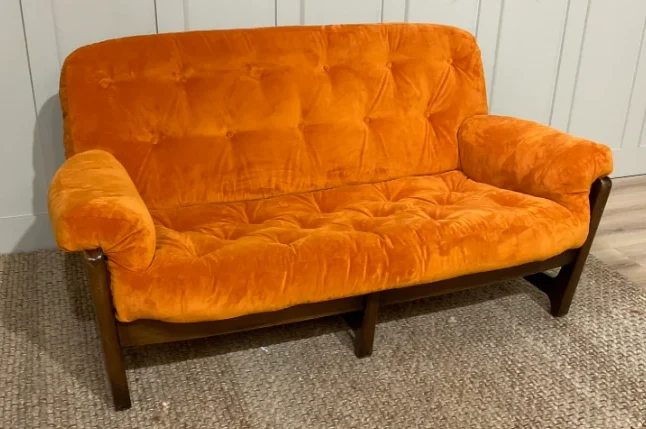January

20% OFF
Upholstery Recovering
FREE 4 x Scatter Cushions
with Sofa Re-Upholstery
Subject to T&Cs
January

20% OFF
Upholstery Recovering
FREE 4 x Scatter Cushions
with Sofa Re-Upholstery
Subject to T&Cs
There is no ‘one size fits all’ method on how to clean upholstery, but there are a few things you can keep in mind to keep your beloved furniture looking fresh.
Before you get started cleaning your upholstery, consider the material that you are cleaning. If you’re unsure on how to clean a certain material, check the label of the fabric. On sofas this can be found on the underside of the body.
If you’re thinking of cleaning bespoke upholstery, speak to an upholstery professional before you do anything to your furniture. Using the wrong cleaning solution or brushes can permanently damage your fabric.
Older and more antique upholstery such as Parker Knoll Upholstery can sometimes require specialist cleaning. This will help to avoid ruining the fabric.
If you have managed to find yourself a label with information on the fabric you want to clean you might find one of these codes:
X – This means that you can only clean it yourself with a vacuum. If you want to get this material cleaned, it will need to be done professionally.
W – One of the more common codes, fabrics marked with W means that you can clean the upholstery with water. Steam is also fine to use.
P or S – This is when the material should only be cleaned with a solvent based cleaner.
SW – This code means that you can use either water or a solvent based cleaner.
Another element you should consider before you jump straight into cleaning your upholstery, think about what you might need to get the job done properly.
Before you begin properly cleaning your upholstery, you will need to ensure that any loose dirt is removed. Dirt, pet hair and crumbs can easily get caught on your upholstery, so it’s important to remove it at the start of your cleaning process.
The best way to remove this sort of dirt is by using a vacuum cleaner. Working from top to bottom is the most effective way to eliminate loose dirt.
In some cases, you might be able to remove the fabric from the furniture. If this is the case, you can simply give the fabric a good shake outside to help remove stubborn dirt.
Once you have identified which stain remover is suitable for your fabric, mix it thoroughly with ¾ water or a solvent based cleaner (if your fabric prohibits this). Be sure to prepare a second bucket with lukewarm water to use a rinse bucket.
Top tip: Before applying to the area you wish to clean, you could first test your concoction on a hidden piece of fabric or spare piece of fabric that your upholstery may have come with.
Before you clean the entire sofa, it would be worth tackling target areas first. Any heavily used areas that have become dark from dirt and oil in our hands or general stains, should be cleaned first.
To stop the spread of dirt, once the dirt starts to come away from the fabric, rinse your brush or microfiber cloth in clean water. This will eliminate the chance of transferring the dirt onto unaffected areas.
If you don’t already have a unique upholstery cleaning solution with you, you can make your own. If your fabric allows for it, you can mix a generous teaspoon of washing up liquid for every gallon of water you use.
Caution: Double check that your fabric allows for water usage before taking this step.
Once you have tested your solution on a sample of the fabric and you’re happy with the results, you can now make a start on cleaning the rest of the couch.
It’s advised that you start at the top and work your way down. Ensure that you rinse the sponge thoroughly so that the fabric doesn’t become drenched with your solution.
Top tip: To remove any soapy residue from the fabric, you can give your upholstery a once-over. Dip a microfiber cloth into clean water, ring the cloth out and go over where you have cleaned with your cleaning solution.
Now you’ve cleaned your upholstery, its time to get the fabric dried. It’s important not to damage the fabric when going through the drying process so be sure to avoid tumble driers or heat sources such as radiators when drying your upholstery.
Air-dry your upholstery to keep the fabric looking healthy and unharmed. You can used a fan or an dehumidifier to speed up the process.
Once you have cleaned your upholstery, there are a few small things you can do to maintain your upholstery looking from.
Some methods are more obvious than others and again should be considered on a cases by cases basis.
If you brush upholstery often (perhaps 2-4 times a month), you will ensure that dirt has less chance of settling on your fabric. You can get specialised fabric brushed that aren’t too harsh on your upholstery.
If your upholstery is located somewhere where it will see heavy usage, you could do with airing it out to keep it looking and smelling fresh.
Pat down cushions outside to help remove odours from the fabric of your upholstery.
Try and keep your upholstery away from direct sunlight or heat.
This won’t particularly affect the cleanliness of your furniture but it will help to avoid your fabrics from drying out or becoming discoloured. If not looked after properly, you may eventually need to look into replacing the foam in your cushions.
Here at Southwest Upholstery, we have years of experience with furniture upholstery for any project. From single pieces of furniture through to seating for restaurants, bars and clubs. Our specialist team will take you through the whole process, advising and guiding you until you get exactly the look and feel you want.